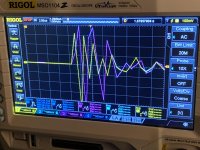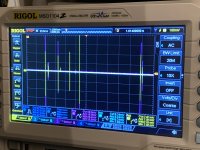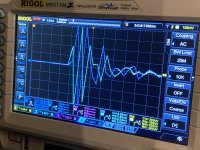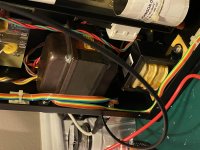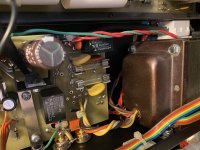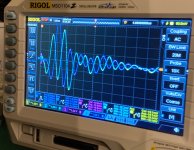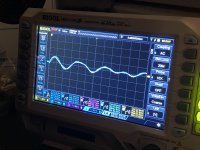Hi,
not sure this is the correct forum, but here goes:
I have a Conrad Johnson ART preamp that is extremely sensitive to power line noise. For example, I might plug in in a laptop charger in another outlet, and the microcontroller goes awry, showing weird stuff on the display, and an audible "hump" in the sound (relay controlled volume, separate transformers for digital control circuit and amplifier). Everything is fine again if I try to change volume, and the front panel indicators go back to looking normal.
I don't think the microcontroller is reset, as a normal startup includes warmup time for the tubes, which isn't initiated when a hiccup occurs. But something gets scared in there, that's for sure.
I've checked the line filter capacitors, which all seem fine. I'm wondering if there might be any small ceramics on the logic board that have failed, so I'll check that as well.
That said, do you have any thoughts as to what might be the issue? Currently, the device is too sensitive to be of practical use.
not sure this is the correct forum, but here goes:
I have a Conrad Johnson ART preamp that is extremely sensitive to power line noise. For example, I might plug in in a laptop charger in another outlet, and the microcontroller goes awry, showing weird stuff on the display, and an audible "hump" in the sound (relay controlled volume, separate transformers for digital control circuit and amplifier). Everything is fine again if I try to change volume, and the front panel indicators go back to looking normal.
I don't think the microcontroller is reset, as a normal startup includes warmup time for the tubes, which isn't initiated when a hiccup occurs. But something gets scared in there, that's for sure.
I've checked the line filter capacitors, which all seem fine. I'm wondering if there might be any small ceramics on the logic board that have failed, so I'll check that as well.
That said, do you have any thoughts as to what might be the issue? Currently, the device is too sensitive to be of practical use.
Last edited:
With 100K ohm input impedance that would up the chances of noisy SMPS injection into the mains supply reaching the audio circuit .
I built one of JLH,s Mosfet amps with a 100K volume control but I don't have a lot of noisy equipment injecting into the electricity supply .
Large value power supply capacitors are useless for this sort of fault and your right small value COG capacitors will help including at the input where their effect ( small value ) will be well above the audio band frequency range .
I built one of JLH,s Mosfet amps with a 100K volume control but I don't have a lot of noisy equipment injecting into the electricity supply .
Large value power supply capacitors are useless for this sort of fault and your right small value COG capacitors will help including at the input where their effect ( small value ) will be well above the audio band frequency range .
Large value power supply capacitors are useless for this sort of fault and your right small value COG capacitors will help including at the input where their effect ( small value ) will be well above the audio band frequency range .
There is currently a 10nf filter cap on each line, plus a ferrite around the power cord. None of the caps are C0G, so at my room temperature they're more like 8nf.
This issue happens also with only power connected (i.e. no audio in or out).
The engineering philosophy of the CJ ART preamp is straight through according to the advertisement of your preamp so the circuit should be a bit minimalist .
While I like that it comes with this type of problem with a high input impedance , could you try paralleling the input with another 100Kohm resistor temporarily just to see if 50Kohm impedance makes any difference ?
Noise entering the amp via the power supply can end up at the sensitive input even if you are not actually playing music .
Can you post a schematic ?
While I like that it comes with this type of problem with a high input impedance , could you try paralleling the input with another 100Kohm resistor temporarily just to see if 50Kohm impedance makes any difference ?
Noise entering the amp via the power supply can end up at the sensitive input even if you are not actually playing music .
Can you post a schematic ?
The fact the uP throws a wobbler when this happens suggests maybe the internal supply to the logic is glitching and dipping when this happens. Power supplies like laptop ones can generate pretty high inrush currents. I wonder if the mains supply is dipping down as that happens and causing the uP to do something it shouldn't.
Perhaps check any grounding is OK at the mains sockets and that nothing is high impedance or floating and so getting a spike on it when you plug the charger in.
Also check the mains voltage is correct and not to close to the lower limit the equipment can operate on. Maybe the rails are right on the verge of not being regulated due to insufficient headroom.
Perhaps check any grounding is OK at the mains sockets and that nothing is high impedance or floating and so getting a spike on it when you plug the charger in.
Also check the mains voltage is correct and not to close to the lower limit the equipment can operate on. Maybe the rails are right on the verge of not being regulated due to insufficient headroom.
I've had power supplies interfere so badly that it made the touch pad stop working on Panasonic Toughbook laptops. Don't recall what was causing the noise but as soon as it was unplugged both laptops worked fine. Not sure which device I would place more blame on for that one.
While I like that it comes with this type of problem with a high input impedance , could you try paralleling the input with another 100Kohm resistor temporarily just to see if 50Kohm impedance makes any difference ?
Noise entering the amp via the power supply can end up at the sensitive input even if you are not actually playing music .
Can you post a schematic ?
Sadly, I don't have any. Only 250 units were made. I'll try playing with the input impedance.
The fact the uP throws a wobbler when this happens suggests maybe the internal supply to the logic is glitching and dipping when this happens. Power supplies like laptop ones can generate pretty high inrush currents. I wonder if the mains supply is dipping down as that happens and causing the uP to do something it shouldn't.
Perhaps check any grounding is OK at the mains sockets and that nothing is high impedance or floating and so getting a spike on it when you plug the charger in.
Also check the mains voltage is correct and not to close to the lower limit the equipment can operate on. Maybe the rails are right on the verge of not being regulated due to insufficient headroom.
Thanks! I didn't consider that - I'll monitor the rails as soon as I get the opportunity.
You said that even turning the volume knob will cause issues?
This looks like a DC voltage is running thru the volume pot/switch or there is some HF oscillation....
Do you have short circuit RCA plugs (shorting caps) to short the inputs?
This looks like a DC voltage is running thru the volume pot/switch or there is some HF oscillation....
Do you have short circuit RCA plugs (shorting caps) to short the inputs?
So, there are two 5V regulators on each monoblock. I scoped them to have a look at what happened when I used my new line noisemaker tool (aka laptop charger).
As suspected, heavy ringing occurred, several volts. Now, I measured the regulator output directly, so there are probably reservoir capacitors later in the circuit, but still - wouldn't the 10nf line caps filter this out? It seems to me we are talking noise at about 0.5-1Mhz here - see pics.
That being said, I wonder if the power supply is not to blame here - the data bus (rainbow cables) is going right alongside both transformers and the power cord (you can see a white ferrite on one of the pics, the power chord goes through there. Could it be that EMF affects the data bus?
As suspected, heavy ringing occurred, several volts. Now, I measured the regulator output directly, so there are probably reservoir capacitors later in the circuit, but still - wouldn't the 10nf line caps filter this out? It seems to me we are talking noise at about 0.5-1Mhz here - see pics.
That being said, I wonder if the power supply is not to blame here - the data bus (rainbow cables) is going right alongside both transformers and the power cord (you can see a white ferrite on one of the pics, the power chord goes through there. Could it be that EMF affects the data bus?
Attachments
If we are talking about the data bus for the processor then that should not allow mains induced interference to be directly fed into the audio circuits as CJ expressly state that the processor ONLY controls the switching of the relays whose contacts are independent of the electrical pulses fed to the relay,s coil.
Sure, but when this issue happens, the display goes haywire and relays start clicking. The MCU is fine - if I change the volume, the display (and current source) gets updated again. So I'm wondering if EMF is messing with signals on the data bus, causing this strange behaviour. Popping in the audio might simply be related to relays going nuts.
The interface seems quite simple - for the relay part, the data lines directly feed a few shift registers which in turn controls the relays through a darlington array. I would assume the display is no different.
The interface seems quite simple - for the relay part, the data lines directly feed a few shift registers which in turn controls the relays through a darlington array. I would assume the display is no different.
Well yes that seems logical so the "end of game " strategy would be to stop this happening which would require a quality interface filter between the amplifier mains input and the actual mains supply .
As long as this is induced interference but have you checked for radiated interference ?
If the frequency is a few MHz then get hold of an old transistor radio and tune it across the bandwidth to see if you pick up the same interference or buy a spy bug detector of very wide bandwidth ( I have one ) and use that to trace any RF transmitted interference .
You could also try a computer mains conditioner plugin.
As long as this is induced interference but have you checked for radiated interference ?
If the frequency is a few MHz then get hold of an old transistor radio and tune it across the bandwidth to see if you pick up the same interference or buy a spy bug detector of very wide bandwidth ( I have one ) and use that to trace any RF transmitted interference .
You could also try a computer mains conditioner plugin.
As long as this is induced interference but have you checked for radiated interference ?
If the frequency is a few MHz then get hold of an old transistor radio and tune it across the bandwidth to see if you pick up the same interference or buy a spy bug detector of very wide bandwidth ( I have one ) and use that to trace any RF transmitted interference .
You could also try a computer mains conditioner plugin.
Can you unbolt the transformer as a test and physically move it away a little?
duncan2, when you say induced interference, would that be the same as conductive? I think all of this is radiated interference. I assume conducted interference would be handled by the line caps?
Regarding moving the transformers - I'm not sure if that would work. The power cord is soldered to the circuit board and is from there routed to each of the two transformers. Again, I would assume any conducted interference to be handled by the line filter (or if it is a line filter I'm looking at, I haven't really tested, just assumed).
I can try a mains conditioner, however the owner of this device tried to attach it to a PS Audio power regenerator (AC->DC->AC) without any noticeable improvement.
If you look at the photo, you can see the mains cable going past the transformer and underneath the PCB. The yellow ceramics are 10nf, same with the smaller red ones (there are two of them).
Attachments
If you think its radiated interference rather the induced /injected via the mains supply then do as I say prove it by using some sensitive wide-bandwidth radio or "bug locator " to see if they generate noise when tuned or moved about .
If that SMPS is generating that much RF then its time to bin it /replace it as it will cause problem on other electronic equipment in the house.
If it induced via the mains then do as Mooly says OR--- screen the wiring by wrapping say tin foil round it and earthing the foil just as a test.
I have never been beaten when locating interference it just takes time in some cases to locate that why I make life easier by buying a miniature bug tracer --MUST-- be wide-bandwidth its handy for locating insipid oscillation on a power amplifier design without using other test gear.
If that SMPS is generating that much RF then its time to bin it /replace it as it will cause problem on other electronic equipment in the house.
If it induced via the mains then do as Mooly says OR--- screen the wiring by wrapping say tin foil round it and earthing the foil just as a test.
I have never been beaten when locating interference it just takes time in some cases to locate that why I make life easier by buying a miniature bug tracer --MUST-- be wide-bandwidth its handy for locating insipid oscillation on a power amplifier design without using other test gear.
I was thinking it was radiated from the main supply, somehow. But I think I will have to retract that statement, it probably is induced.
As I don't have any bug tracer etc, I tried using my scope probes as antennas (I guess now is the time to shoot me down). Anywho, that didn't work so well, no luck.
I tried a feeble attempt at isolating the power cord from the data bus lines, but to no avail.
I measured again, and this time I noticed something that must have slipped earlier for some reason - one of the monoblocks has the inteference shifted about 180 degrees (see attached pic). Any ideas as to what could be the cause of this? All of the devices are connected to the same power strip, and the power supplies should be identical as far as I know.
I'm measuring on the output pin of each of the 5V regulators that are on board (i.e. 4 in total). There might be some filtering after this, but I would assume interference like this (about 1Mhz?) would be caught by the line filter, or something else before the regulator. Or is that a wrong assumption?
I will map the circuit and post a drawing later, but in the meantime I'm very thirsty for input here. 🙂 🙂
As I don't have any bug tracer etc, I tried using my scope probes as antennas (I guess now is the time to shoot me down). Anywho, that didn't work so well, no luck.
I tried a feeble attempt at isolating the power cord from the data bus lines, but to no avail.
I measured again, and this time I noticed something that must have slipped earlier for some reason - one of the monoblocks has the inteference shifted about 180 degrees (see attached pic). Any ideas as to what could be the cause of this? All of the devices are connected to the same power strip, and the power supplies should be identical as far as I know.
I'm measuring on the output pin of each of the 5V regulators that are on board (i.e. 4 in total). There might be some filtering after this, but I would assume interference like this (about 1Mhz?) would be caught by the line filter, or something else before the regulator. Or is that a wrong assumption?
I will map the circuit and post a drawing later, but in the meantime I'm very thirsty for input here. 🙂 🙂
Attachments
If the phase of one of the monoblocks is shifted 180 degrees then concentrate on that one for causes of this type of fault .
Normally in fault finding ( if its not obvious ) you start at the input with your oscilloscope probe and work your way through the amp till you see oscillation .
We are not tracing a fault using a sine wave signal input but trying to LOCATE HF oscillation which isn't the same in fault location .
Where is the earliest oscillation found in your amplifier --from input to output ?
Normally in fault finding ( if its not obvious ) you start at the input with your oscilloscope probe and work your way through the amp till you see oscillation .
We are not tracing a fault using a sine wave signal input but trying to LOCATE HF oscillation which isn't the same in fault location .
Where is the earliest oscillation found in your amplifier --from input to output ?
What happens if you plug this laptop charger into another outlet in another room and/or on another ring main such as upstairs vs downstairs circuit.
Does it still glitch?
Does it still glitch?
Mooly: I tried plugging in the laptop charger in the kitchen circuit upstairs. I've attached how it looked on the scope. There was a reading, but it didn't trip the preamp.
Again, these measurements are taken on the output pin of the 5V regulators in the preamp's power suppy section (AC coupling).
Again, these measurements are taken on the output pin of the 5V regulators in the preamp's power suppy section (AC coupling).
Attachments
- Home
- Amplifiers
- Power Supplies
- Conrad Johnson preamp hiccups on line noise
